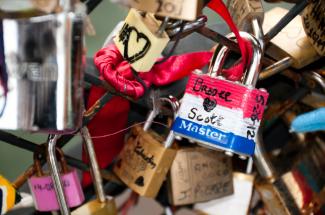
The Triana Bridge in Seville is one of the most romantic parts of the city. I’ve walked across it many times and I always see people getting their pictures taken there – especially couples – with the calm waters of the Guadalquivir River in the background. But this romantic location plays a part in another tradition for love-struck visitors: For if you walk across this bridge, you will see an interesting collection of padlocks attached to its iron railings. You will see a collection of love locks.
Love locks are a growing phenomenon in many cities in Europe. In general, these are padlocks that couples attach to public fixtures, like bridges, as a symbol of their relationship. And by throwing away the key, this represents their eternal love and commitment for each other – and their relationship becomes sealed forever.
Nobody really knows where love locks come from; there are many theories. For example, many people believe that the tradition comes from the book ‘Ho voglia di te’ (2006) by Italian author Federico Moccia, whose characters attach a padlock to a lamppost on the Milvian Bridge in Rome and throw the key into the river. And ever since, the Milvian Bridge has attracted couples from all over the world who come to attach their own symbol of love.
But the Most Ljubavi (‘The Bridge of Love’) in Vrnjačka Banja, Serbia is completely covered in love locks – and some have apparently been there since before the Second World War. The bridge had been a meeting place for an engaged couple, a woman and an officer, whose engagement then broke up when the man fell in love with somebody else. Devastated, the woman eventually died of a broken heart. So, young girls began to write their name and the name of their loved one onto a padlock and attach it to the bridge, throwing the key into the river. By binding their love, they hoped to never share the same fate as the heartbroken woman.
However, even symbols of love can cause problems.
There is a lot of concern that love locks are actually damaging bridges. For example, a few years ago, the lamppost on the Milvian Bridge became so threatened by the weight of all its love locks that it nearly collapsed. So, to avoid further damage, many padlocks were removed and people were encouraged to stop this tradition. But in 2007, the mayor of Rome decided to have steel columns constructed and these were placed on the bridge for couples to hang up love locks again.
Similarly, there had been concerns in Moscow, Russia about the Luzhkov Bridge. However, the city offered an alternative: a metal tree, to be used for attaching love locks. And now there are many more trees, creating a whole forest of love locks.
But not every city is as accepting to this tradition as Rome or Moscow – like Seville.
Yes, there's a collection of love locks on the Triana Bridge, but while couples think that their symbol of love will stay locked forever, Seville authorities have them removed. The city considers these padlocks a form of vandalism, believing that they are ugly and that they ruin the beauty of their bridge. Nonetheless, love prevails as couples resist and continue to attach padlocks to the bridge’s railings.
Love locks come with a lot of superstition. Whether it’s a form of protection or just an expression of affection, people are clearly enchanted by the idea of eternal love. But with just a padlock and a key, can love really be bound forever? Well, many couples think so, using their love lock as a physical token of their relationship. And this tradition is now so popular in many European cities - in general, the majority of love locks are left untouched, and some are even encouraged; however, many are also removed.
Therefore, for all those love-struck couples on the Triana Bridge in Seville, will their love really remain eternal once the physical token of their relationship has been destroyed?
Or is that just a silly superstition?
Language level
Topics
Discussion
What do you think about 'love locks'? Is it a silly superstition or the key to finding true love?
